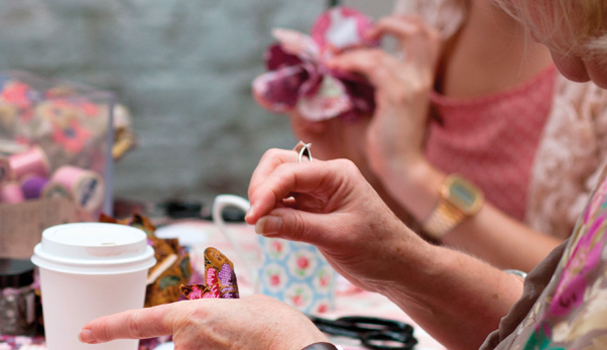Once thought to be the preserve of grandmothers and fusty old aunties, knitting has been making a very steady comeback. Stitch by stitch, knitaholics have been switching books and iPads for needles, a ball of yarn and a pattern to wile away afternoons in the park, evenings in front of the fire or just ten-minute Tube journeys.
The numbers certainly seem to back up anecdotal evidence that knitting is becoming cool again. In the past five years, sales of wool have soared 50% from £180m in 2007 to £270m last year. The UK’s wool mills have had to hit the accelerate button to keep up with demand: in 2011, British mills produced 40 million kilos of wool – up from 32 million just two years previously. And it’s not just denizens of the UK with a taste for our fibre: more than 70% of wool products made in the UK end up abroad.
There are a number of factors that have together bolstered the popularity of knitting. Firstly, love them or loathe them, celebrities do have an enormous effect on popular culture. And when knitting proponents reportedly include the likes of Hollywood actress Uma Thurman and Sex And The City star Sarah Jessica Parker – and even queen of cool herself Kate Moss is spotted with a ball of yarn – it’s only a matter of time before the craze catches on among us mere mortals.
Even Prince Charles has raved about the benefits of wool and natural fibre. The royal heir is the patron of the Campaign for Wool, a five-year campaign to raise awareness of the industry in the UK. Now in its fourth year, the team behind Campaign for Wool works with designers and fashion labels, as well as the mills themselves, to hold events and run projects. Last year’s activity, for example, included Wool School, a project that saw 11 designers team up with 11 high street stores such as Hobbs, Jigsaw and Topshop to produce a range of limited edition jumpers to celebrate October’s Wool Week.
Savvy businesses are only too happy to hop on the knitting bandwagon. The Wool Room, established in 2009, emerged out of established wool merchants H Dawson. The family-run business has been operating for about 125 years, buying and selling wool and matching the right fibres to the right purposes and businesses that require them.
Current CEO Jo Dawson decided something needed to be done about the inertia in the wool trade. “He said, ‘Look, I’m so frustrated with the wool industry: it’s always looking backwards rather than forwards’,” explains The Wool Room’s MD, Chris Tattersall. The original plan for the spin-out was that it would be a business hub where companies could promote themselves and sell wool products. But when that failed to garner much interest, they instead opted to retail their own products.
The Wool Room sells mainly bedding, including wool duvets, blankets, throws and pillows. They also do a roaring trade in babies’ blankets and associated paraphernalia. The business as a whole is going great guns: from a £300,000 business last year, this year The Wool Room is expected to turn over £1.3m.

Design by Melanie Porter
But Tattersall says the retailer’s raison d’etre isn’t merely to flog its wool products, but to educate people about the benefits of natural fibres. “We want to present wool as being fun and contemporary, not fuddy duddy, old-fashioned or itchy and scratchy,” he explains. “We want to try to appeal to people to get buying this fantastic fibre that’s all around us in this country. We’re lucky to have some of the best wool in the world, but it’s been long forgotten. A certain generation has grown up with a disposable society of synthetics so we’re trying to get back to basics,” says Tattersall.
He seems to have a point. The increased appetite for wool goods has been driven in part by a desire for more hardy products that will survive longer than a £5 jumper from one of the bargain retailers, but also an increased interest in sustainability and provenance.
“People are really starting to care about where their product is coming from, where it’s sourced, how it’s made and the story behind the product,” says Jade Harwood, creative director and co-founder of Wool & The Gang, which sells high-fashion woollen garments, as well as DIY kits so customers can make their own clothes. “It’s no longer just about buying something off a Primark shelf.”
For Wool & The Gang, the most successful part of its business is its DIY kits, which currently comprise about 80% of sales online and 50% in-store (they partner with a few hand-picked shops in order to maintain a retail presence). But Aurelie Nicod Popper, Harwood’s co-founder and co-creative director, says it remains important to have the high-fashion side of the business as it gives an aspirational feel to the brand. “I think it’s really important to establish ourselves as a fashion brand,” says Nicod Popper. “We want people to think, ‘I want to be like that girl. I can make it myself and be really cool,’” she says.
One of the central tenets to Wool & The Gang’s business is being interactive with its community. So customers will post pictures to the company’s Instagram account of the items they’ve made. “You can see people are so proud of the piece they’ve made. It’s a feeling of accomplishment to say, ‘I’ve made this with my hands,’” says Harwood.
Nicod Popper says often it’s an outlet for creativity. “Lots of people don’t have very creative jobs, and they’ll say to us, ‘Thanks to Wool & The Gang, I’m creative’. It’s their ambition to make something,” the designer explains.
This newfound appetite for creativity is benefitting entrepreneurial businesses above and beyond those in the wool trade. Nicola Barron’s Homemade London offers courses in all sorts of crafts, from lampshade-making to sewing classes. (The eagle-eyed readers among you will most likely recognise Barron from her Start-up Diaries column on the back page of EB.)

Barron says the most common kind of customer at Homemade London is a female lawyer, closely followed by accountants. “They don’t have a creative outlet,” she agreed. “And they’ve got money, so they don’t want to be going to the village hall, or whatever. They always say it’s such a stress-reliever to come here,” she smiles.
Whatever course or class undertaken by the customer, Barron’s team of designers and craft experts ensure that the Homemade London client finishes at least one item. “It gives them a sense of achievement,” says Barron.
But the West End-based entrepreneur says that, despite the cost, there is more of a passion for hand-crafted items than ever before. “They’re never going to be cheap, but that’s the whole point. It’s a very slow process, which means you really earn it. It’s definitely not something you can acquire off the shelf. It’s personalisation, something different – all of those reactions against a throwaway culture.”
Melanie Porter
Designer and knitting extraordinaire

Five years ago, Melanie Porter was a discontented designer working for upmarket fashion brand Pure Collection. “I started getting a bit frustrated with doing all of the designs, but not actually making anything,” she explains.
So she embarked upon a side project and bought some chairs that needed a bit of TLC. She set out to upholster them herself, but couldn’t find any fabric she liked. “So I decided I would make my own fabric,” she says. But this wasn’t any old fabric: Porter knitted covers for the chairs. Her artistic flair and unusual designs captured the imagination of those who knew her and soon all of her spare time was spent with knitting needles and a bundle of wool.
“I made a few while I was working and sold them to friends and friends of friends,” Porter explains. “In late 2008 to early 2009 I left fashion design and started doing interior pieces full time.”
Full time and then some, by all accounts. “At the moment I’m extremely busy,” says the entrepreneur. “Knitting is taking over every single corner of our household.”
Porter’s revenue is in two streams: firstly, bespoke furniture. Customers will often give her a chair or a sofa they’d like her to cover with her innovative designs. The second is the pret-a-porter collection (i.e. the stuff she’s already made). This includes chairs, sofas, lamps, cushions and even knitted wallpaper.
It’s been a busy month, even by Porter’s standards, as she’s had a pop-up shop in Seven Dials, Covent Garden, London. A contact who she had worked with before offered her a space last year, and then this March she combined forces with another designer / maker Zoe Darlington to take a shop with two-floors for three weeks up to April 3.
“One of the weekends it was snowing and I was looking outside and thinking, ‘I wouldn’t be shopping in this weather.’” Luckily, there were committed shoppers who were willing to brave the wintry conditions and Porter’s business continues to thrive. “Despite the terrible weather, it’s gone brilliantly,” Porter says. ![]()
Share via:


















































